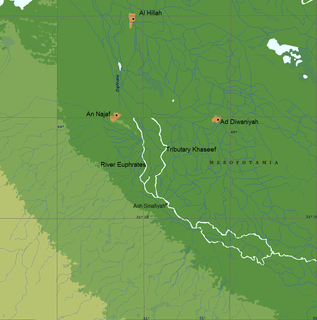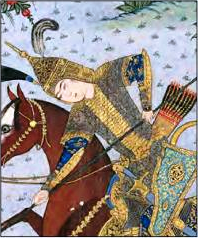
The Muslim conquest of Persia, also known as the Arab conquest of Iran, led to the fall of the Sasanian Empire of Iran (Persia) in 651 and the eventual decline of the Zoroastrian religion.

Ikrima ibn Abi Jahl Amr ibn Hishām was a leading opponent-turned companion of the Islamic prophet Muhammad and a Muslim commander in the Ridda wars and the conquest of Syria. He died during the Battle of Yarmouk.

The Battle of the Bridge or the Battle of al-Jisr was a battle at the bank of the Euphrates river between Arab Muslims led by Abu Ubaid al-Thaqafi, and the Persian Sasanian forces led by Bahman Jaduya. It is traditionally dated to the year 634, and was the only major Sassanian victory over the invading Muslim armies.
The Battle of Dathin was a minor battle during the Arab–Byzantine Wars between the Rashidun Caliphate and the Byzantine Empire in February 634, but became very famous in the literature of the period.

The Battle of Firaz was the last battle of the Muslim Arab commander Khalid ibn al-Walid in Mesopotamia (Iraq) against the combined forces of the Byzantine Empire and the Sasanian Empire.

The Battle of Ullais was fought between the forces of the Rashidun Caliphate and the Sassanid Persian Empire in the middle of May 633 AD in Iraq, and is sometimes referred to as the Battle of Blood River since, as a result of the battle, there were enormous amounts of Sassanian and Arab Christian casualties.

The Battle of al-Qadisiyyah also spelled Qadisiyah, Qadisiyya, Ghadesiyeh or Kadisiya, fought in 636, was a decisive battle between the Arab Muslim army and the army of the Sasanian Empire of Persia during the first period of Muslim conquests.
Khalid ibn al-Walid ibn al-Mughira al-Makhzumi was an Arab Muslim commander in the service of the Islamic prophet Muhammad and the caliphs Abu Bakr and Umar who played a leading role in the Ridda wars against rebel tribes in Arabia in 632–633 and the early Muslim conquests of Sasanian Iraq in 633–634 and Byzantine Syria in 634–638.
Jalinus was a 7th-century Armenian dynast, who was one of the leading figures in Sasanian Iran. He was the commander of the guard over Khosrow II, during the latter's imprisonment. Jalinus was a Sasanian commander during the Arab conquest of Iran.
Azadveh-i Banegan Mahan-i Mihr-Bondad, known in Arabic sources as Azadhbih ibn Baniyan Mahan ibn Mihrbundadh, better simply known as Azadbeh, was an Iranian nobleman, who served as the Sasanian marzban of al-Hira in the period 617-633.
Aspad Gushnasp, known as Gousdanaspa in Byzantine sources, was an Iranian commander (hazarbed) of the Sasanian royal guard, who played a key role in the overthrow of the last great Sasanian king (shah) Khosrow II and the enthronement of the latters son, Kavad II Sheroe.
Mah-Adhur Gushnasp, also known by the Arabicized form of Mahadharjushnas, was an Iranian nobleman who served as the wuzurg framadār of the Sasanian Empire during the reign of the child ruler Ardashir III.
Busbuhra was a local ruler of Aramean origin, who shifted alliance between the Rashidun Caliphate and the Sasanian Empire, to remain on his throne.

Abarsas was an ancient district in present-day southern Iran. It is first mentioned in the early 3rd-century as part of the fief of the Parthian dynast Mihrak. In 222, his fief was conquered by the Sasanian king Ardashir I, who two years later had it incorporated into the administrative division of Ardashir-Khwarrah.
ʿAttāb ibn Asīd ibn Abī al-ʿĀs ibn Umayya ibn ʿAbd Shams was a member of the Banu Umayya (Umayyad) clan who, at a young age, was appointed governor of Mecca in the wake of its conquest by the Islamic prophet Muhammad in 629/30. He had converted to Islam after Mecca was conquered by the Muslims. Due to its sanctity for the Muslims, the governorship of Mecca was a coveted post and Attab was appointed over several other more experienced potential candidates from the Quraysh tribe, which dominated the city. He continued in the post through the caliphate of Abu Bakr until 634, according to 8th/9th-century historian al-Waqidi, or until 642 during the rule of Caliph Umar, according to the 9th-century historian al-Tabari. Attab was married to Juwayriya, a daughter of Abu Jahl, one of the early principal leaders of Qurayshite opposition to Muhammad. According to al-Waqidi, Attab died in 634, while al-Tabari held that he died in 644. His son Abd al-Rahman was a prominent soldier in Aisha’s army who was slain by Malik al-Ashtar in the Battle of the Camel in 656.
Abdallah ibn Khalid ibn Asid was a member of the Umayyad dynasty and governor of Kufa in 673–675 during the reign of Caliph Mu'awiya I.

Gordiya was an influential Iranian noblewoman from the House of Mihran, who was first the sister-wife of the distinguished military leader Bahram Chobin, then the wife of the Ispahbudhan dynast Vistahm, and ultimately the wife of the last prominent Sasanian emperor, Khosrow II.
Ghalib ibn Abd Allah al-Laythi also known as Ghalib ibn Fadala al-Laythi, was an early companion and commander of the Islamic prophet Muhammad. During the prophet's lifetime, he led several expeditions against the polytheistic Bedouin tribes. He later participated in the conquest of Iraq in 634–636 and briefly as a commander in Khurasan in 668–671.
Al-Ḥārith ibn Hishām ibn al-Mughīra ibn ʿAbd Allāh was a companion of Muhammad, a noble of the Banu Makhzum and a participant in the Muslim conquest of Syria until his death.
Al-Hakam ibn Amr al-Ghifari was a companion of Muhammad and the Umayyad governor of Khurasan and commander of Arab expeditions into Transoxiana from 665 until his death in Merv.








